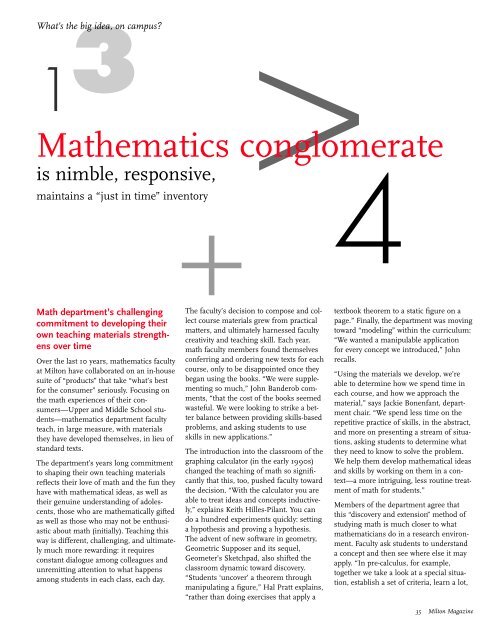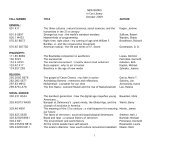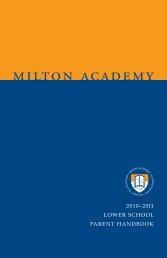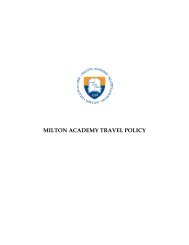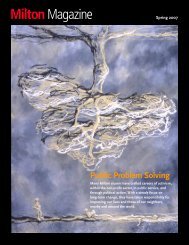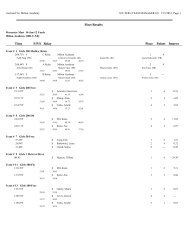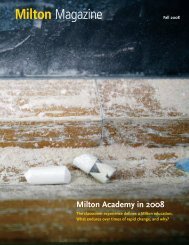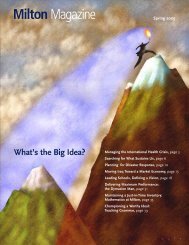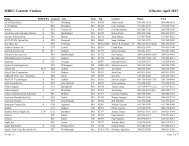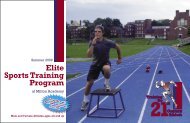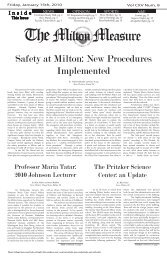Mathematics conglomerate
Mathematics conglomerate
Mathematics conglomerate
Create successful ePaper yourself
Turn your PDF publications into a flip-book with our unique Google optimized e-Paper software.
13>What’s the big idea, on campus?<strong>Mathematics</strong> <strong>conglomerate</strong>is nimble, responsive,+ 4maintains a “just in time” inventoryMath department’s challengingcommitment to developing theirown teaching materials strengthensover timeOver the last 10 years, mathematics facultyat Milton have collaborated on an in-housesuite of “products” that take “what’s bestfor the consumer” seriously. Focusing onthe math experiences of their consumers—Upperand Middle School students—mathematicsdepartment facultyteach, in large measure, with materialsthey have developed themselves, in lieu ofstandard texts.The department’s years long commitmentto shaping their own teaching materialsreflects their love of math and the fun theyhave with mathematical ideas, as well astheir genuine understanding of adolescents,those who are mathematically giftedas well as those who may not be enthusiasticabout math (initially). Teaching thisway is different, challenging, and ultimatelymuch more rewarding: it requiresconstant dialogue among colleagues andunremitting attention to what happensamong students in each class, each day.The faculty’s decision to compose and collectcourse materials grew from practicalmatters, and ultimately harnessed facultycreativity and teaching skill. Each year,math faculty members found themselvesconferring and ordering new texts for eachcourse, only to be disappointed once theybegan using the books. “We were supplementingso much,” John Banderob comments,“that the cost of the books seemedwasteful. We were looking to strike a betterbalance between providing skills-basedproblems, and asking students to useskills in new applications.”The introduction into the classroom of thegraphing calculator (in the early 1990s)changed the teaching of math so significantlythat this, too, pushed faculty towardthe decision. “With the calculator you areable to treat ideas and concepts inductively,”explains Keith Hilles-Pilant. You cando a hundred experiments quickly: settinga hypothesis and proving a hypothesis.The advent of new software in geometry,Geometric Supposer and its sequel,Geometer’s Sketchpad, also shifted theclassroom dynamic toward discovery.“Students ‘uncover’ a theorem throughmanipulating a figure,” Hal Pratt explains,“rather than doing exercises that apply atextbook theorem to a static figure on apage.” Finally, the department was movingtoward “modeling” within the curriculum:“We wanted a manipulable applicationfor every concept we introduced,” Johnrecalls.“Using the materials we develop, we’reable to determine how we spend time ineach course, and how we approach thematerial,” says Jackie Bonenfant, departmentchair. “We spend less time on therepetitive practice of skills, in the abstract,and more on presenting a stream of situations,asking students to determine whatthey need to know to solve the problem.We help them develop mathematical ideasand skills by working on them in a context—amore intriguing, less routine treatmentof math for students.”Members of the department agree thatthis “discovery and extension” method ofstudying math is much closer to whatmathematicians do in a research environment.Faculty ask students to understanda concept and then see where else it mayapply. “In pre-calculus, for example,together we take a look at a special situation,establish a set of criteria, learn a lot,35 Milton Magazine
=15<strong>Mathematics</strong> department faculty, left to right, front: Terri HerrNeckar, MarthaJacobsen, Jeanne Jacobs, Heather Sugrue, Erica Banderob, Gregg Reilly, andKeith Hilles-Pilant; back: Geoff Theobald, Steve Feldman, Anne Kaufman, PeterKahn, Hal Pratt, John Banderob, Juan Ramos, and Jackie Bonenfant, chair.and then zoom out to test where elsethose criteria might apply,” says Keith.“They might apply to circular motion, forinstance, or a field of objects that work ina similar way.”Writing your own teaching materials takestime and work, and it fosters a collegialenvironment that members of the departmentwho have come from other schoolsexperience as rare and intellectually invigorating.“You understand,” says Jackie,“that to do the best work with students,you need to trust and depend upon yourdepartment colleagues.”“As a department, and as a group of individuals,we have had to think and talkabout what we are teaching, why we areteaching it, and how best to teach it; it’san essential and ongoing conversation,”says Terri HerrNeckar. All those who teachsections of a given course meet onceeach week; teachers of several courseshave many meetings. They discuss howclasses have gone and roadblocks thathave appeared; they agree upon commonhomework assignments and who willwrite an upcoming quiz. The discussionsinclude: “What way would you use to solvethis problem?” or “I want to introduce thisconcept. Do you have an effective problemto do that?”The outcome of teacher collaboration andattention to the craft of teaching is a curriculumthat is responsive, efficient, customized,open-ended. “I teach two classesthat each have a single section of students,”Erica Banderob says. “I writesomething up after each class. It’s not thesame as last year; it fits exactly. When I seea need, I respond with the right thing,tomorrow!” Rather than following the preordainedsequence in a textbook, “having adata base of our own materials gives usthe confidence to change the flow, basedon the students,” Terri notes.When he arrived at Milton almost 20years ago, Keith Hilles-Pilant designedMath 7 for students who have alreadytaken at least two years of advancedplacement-level calculus. “The content iscompletely different every year,” Keithsays, “based on the interest of the students.I poll the incoming students andtogether we establish the syllabus for thecoming year. This year, the students wereinterested in studying mathematicalphysics, so we are doing that. Along withthe students, I generate the materials forthe course. The result is a book, or perhapsa research journal is a more appropriatename for it. My hope is that the studentswill not only learn, but also discoverthat they can and want to do their ownresearch.”Not surprisingly, students respond well tomath that is designed just for them. Eachstudent keeps a notebook, compiling dailythe teaching materials from faculty mem-36 Milton Magazine
ers along with their own work. “Whenyou give students a new section of the‘text’ each day, every day is important. Thestudents know the pages are the work ofthe faculty in the department and they sortof share in our pride of ownership,” saysSteve Feldman. “When a student asks ateacher why he or she is studying this orthat, a faculty member can easily answerthe question.”Students are responsible for building theirnotebooks; therefore, they are in charge ofthe key resource for the course. (The facultykeep a close eye on the Class IV notebooks,as they emerge.) In this environment,note-taking increases in importance:students can’t easily look up in abook the information they miss, althoughthey might find helpful information onthe Internet. Students learn to use otherresources, too, like each other.Students are much more aware of theirhomework; they have a sense of ownershipfor it, and it becomes part of theiroverall math notebooks. “Having the samehomework as others in different sectionsof the course is helpful, too,” HeatherSugrue notes. “They’re likely to work on ittogether, in the library, the student center,or the dorm. The conversations stretchacross sections.”82“We have the technology now to producemuch more professional-looking materials,”John says, and reworking the materialsis constant and demands time. Thetransition from textbooks to facultydevelopedmaterials is the most difficultpart; the up ramp is steep, and it takes twoto three years to come up with a good criticalmass of material. After that, teachingwith these materials is easier, mainlybecause it’s not boring, it’s more effectiveand much more efficient.New technological developments that areaffecting the teaching environment andsparking creativity today are digital projectorsand SMART Boards. “The next bigquestion,” Jackie says, “is whether or notwe’ll use a computer algebra system(CAS). Students can use calculators with aCAS on standardized tests and AP tests,so that’s the next issue we will need toaddress.”Providing the best possible math experiencefor students has been the mathdepartment’s abiding goal, as they workedclosely together to shape pertinent, challengingmaterial year after year. “This styleof teaching,” says Heather, “is what makesme want to stay at Milton. Not manyschools are doing this: I feel I can contributeto students’ success on a dailybasis.”Cathleen Everett“We spend less time on the repetitivepractice of skills, in theabstract, and more on presentinga stream of situations, asking studentsto determine what theyneed to know to solve the problem.We help them develop mathematicalideas and skills by workingon them in a context—a moreintriguing, less routine treatmentof math for students.”—Jackie Bonenfant,Department Chair37 Milton Magazine


